The Best Workout Moves for Bad Knees
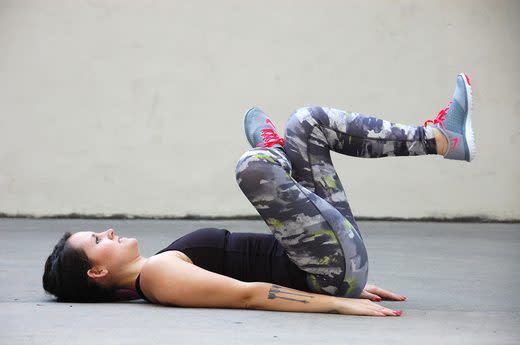
Get the best exercises for bad knees. (Photos: Corey Hartford)
Knee injuries account for 15 percent of all sports injuries, according to the American Academy of Podiatric Sports Medicine, but there are likely scores of people who experience chronic knee pain without having an acute injury. The key to recovery and prevention of future injuries is a program of corrective exercises. “You should strengthen the muscles surrounding the knee to relieve some stress from the joint without causing pain to it,” says Alejandro Rojas, head of fitness at Health LA. “Try exercises that help strengthen your muscles by lengthening them. Use no or very little weight so you don’t create stress to your knees.”
We’ve gathered the best stretches and exercises to help ease the tension on your knee joint caused by tight muscles as well as to strengthen the surrounding muscles, often the cause of knee pain in the first place. These exercises are mainly meant for those with non-contact injuries caused by muscle weakness and imbalance, so these exercises might not be right for everyone. Consult your doctor, orthopedist or physical therapist before beginning any exercise regimen, and if you feel any pain while doing these exercises, stop immediately.

Overhead Squat Assessment
Before starting on this series of corrective exercises, assess where your strengths and weaknesses lie within your knee joint. The NASM recommends the overhead squat assessment. Perform a squat by bending your knees and sinking your hips back as if you were sitting in a chair while raising your arms over your head. “Look for the knees to do two things: move in (adduction) or move out (abduction),” says Maurice Williams, NASM master trainer and owner of Move Well Fitness Academy.
“Both movements indicate some sort of movement compensation and could eventually lead to injury.” If your knees collapse inward when you squat, you’ll need to stretch your calves, inner thighs, hamstrings and hip muscles and strengthen your shin and glute muscles. But if your knees move outward, stretch your calves, glutes and hamstrings and strengthen your inner thighs, back of knee and glute muscles.
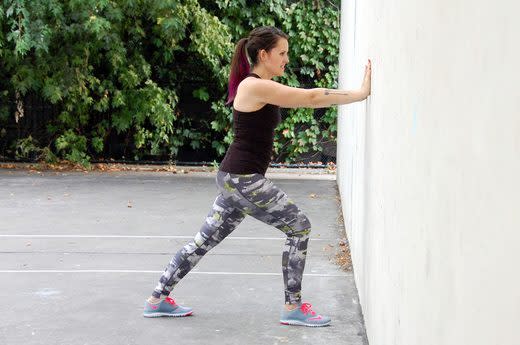
STRETCH 1: Calf Stretch
The knee is a “dummy joint,” meaning it doesn’t operate on its own, says master trainer Maurice Williams. Instead, it works in conjunction primarily with the hip and ankle joints. “If you can get the calf muscle to stretch and be in a more relaxed position, that will take some of the undue stress off the knee,” he says. HOW TO DO IT: Facing a wall, brace yourself with both hands as you step one foot a few feet in front of the other. Bend the front knee, keeping it stacked over the front foot, but keep the back leg straight. You should feel the stretch in the calf of the leg that’s behind you. Hold the stretch statically for 30 to 60 seconds for one to two sets.
Related: 9 Ways to Get the Most Out of Cardio Machines
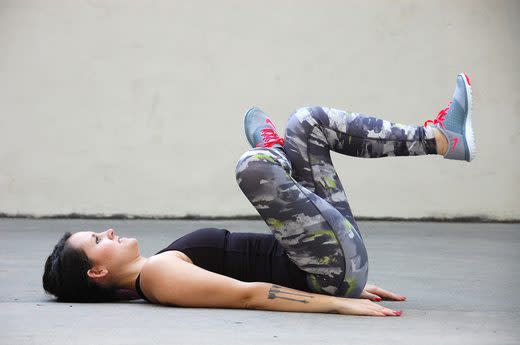
STRETCH 2: Reclined Piriformis Stretch
This stretch targets a muscle in the gluteal part of the upper leg. “The piriformis muscle typically compensates for other muscles in your hip, which can cause knee pain,” says Williams. “If we have something happening at the hips, the piriformis might be working harder than it should be. But if the piriformis relaxes, the knee can relax.” HOW TO DO IT: Lie on your back with your right leg flat on the floor and your left leg raised and knee bent at 90 degrees. Take your left foot and bring it to your right side. Hold for 30 to 45 seconds for one to two sets.
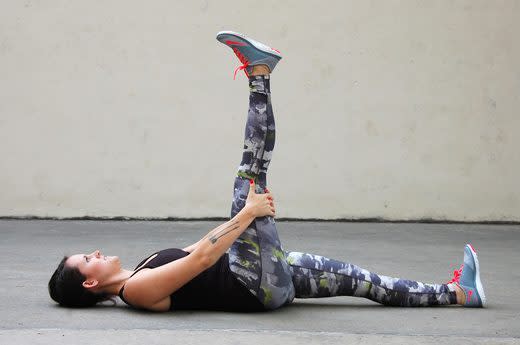
STRETCH 3: Reclined Hamstring Stretch
Lie on your back and lift one leg straight out in front of you while keeping it straight. How high can you lift it? “You should be able to lift your leg at least to 90 degrees,” says Williams. “If not, your hamstrings are too tight, which shortens and pulls the muscles in your knee and affects the joint.” Use this stretch to counteract that. HOW TO DO IT: Start on your back with both legs extended along the floor. Lift your right leg up as high as you can without bending your knee or lifting your other leg. Hold on to either the back of your thigh or your calf and continue to pull your leg toward your torso for 30 to 45 seconds for one to two sets.

EXERCISE 1: Single-Leg Deadlift
The deadlift is the perfect move for strengthening the entire backs of your legs, which will help prevent other muscles from compensating, wearing out and causing pain. “Try single-leg exercises to avoid compensating and to make sure each leg is getting the same amount of work,” says Rojas. However, if you’ve never done deadlifts, if your knees are too weak or if your balance isn’t stable, start with standard deadlifts.
HOW TO DO IT: Stand with both feet hip-distance apart with a dumbbell or barbell in each hand (you can also do this one without weights). Shift your weight to your right foot and hinge at your hip to bend forward so that your torso is parallel to the floor. Extend your arms straight out from your shoulders and let them hang toward the ground. Using only your hamstrings and glutes, contract the muscles in the back of your leg and stand up. Perform six to 10 reps on each side at a slow tempo for one to three sets.

EXERCISE 2: Straight-Leg Raises
“This exercise is good for people with knee problems because it allows them to strengthen the muscles around the knee with no or very little pressure to the knee,” says Alejandro Rojas. It targets primarily the quadriceps and hip flexors, though if you resist on the way down, you’ll also incorporate your hamstrings and glutes.
Related: The 8 Best Cardio Kickboxing Moves
HOW TO DO IT: Lie on your back with your feet extended flat along the floor and your arms by your side. Use your quads and hip flexors to raise your leg up to 90 degrees, pressing into your arms for stability. Hold before lowering down slowly, focusing on using your hamstrings and glutes to lower the leg rather than letting gravity drag it down. Perform six to 10 reps on each side at a slow tempo for one to three sets.
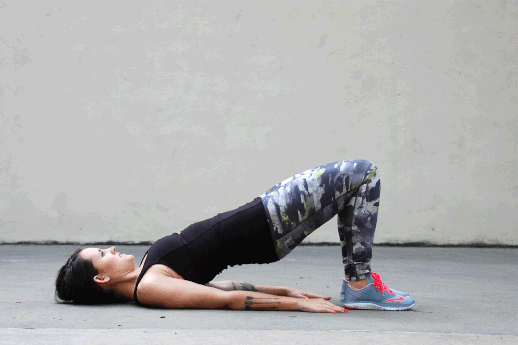
EXERCISE 3: Supine Bridge Kicks
“Bridge kicks strengthen the glutes, hamstrings and torso for core stabilization,” says Rojas. Plus, adding the kicks to the bridge also recruits the hamstrings without putting the raised knee under a lot of pressure. HOW TO DO IT: Lie on your back with your arms by your side and your knees bent and pointing toward the ceiling. Lift your hips and back off the floor so that your weight is in your shoulder blades, arms and feet. Shift your weight into your left foot and raise your right foot off the ground so that your leg is extended out at a 45-degree angle to the floor, contracting your quadriceps as you do, but without locking your knee.
Slowly bring your right foot back to the starting position, but don’t let it touch the floor. Continue for six to 10 total reps on each leg at a slow tempo for one to three sets.
The original article “The Best Workout for Bad Knees“ appeared on LIVESTRONG.COM.
By Rachel Grice
More from LIVESTRONG.COM:
11 Butt-Kicking BOSU Ball Moves
10 Workout Moves You’re Probably Doing Wrong
Must-Try Slideboard Exercises for More Muscle

